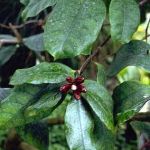| Common Name: |
Climbing Oleander |
| Other Names: |
Smooth Strophanthus, Sawai |
| Botanical Name: |
Strophanus gratus syn. Roupellia grata |
| Genus: |
Strophanus |
| Family: |
Loganaceae |
| Native Location: |
W Africa |
| Cultivation: |
Moist, well-drained, rich soil in sun, with high humidity. |
| Propagation: |
By seed sown when ripe; by ripewood cutting in early spring. Plants take 3 years to reach flowering size when grown from seed; maximum fruit production occurs after 6-10 years. Many flowers fo not set seeds. |
| Harvest: |
Seeds are collected when ripe and processed commercially for the extraction of glycosides. |
| Height: |
9m (28ft) |
| Hardiness: |
Min. 16°C (61°F) |
| Parts Used: |
Seeds |
| Properties: |
An extremely poisonous, diuretic, tonic herb that stimulates the heart. |
| Medicinal Uses: |
Internally, usually by injection, for heart failure, angina, hypertension, pulmonary edema, and hypotension during anesthesia and surgery. |
| Warning: |
Seeds are extremely toxic if eaten.
Excess causes cardiac arrest.
For use by qualified practitioners only.
This herb is subject to legal restrictions in many countries. |
| Bibliography: |
Encylopedia of Herbs by Deni Brown Copyright ©: 1995, 2001 Dorling Kindersley Limited pg 376
|

